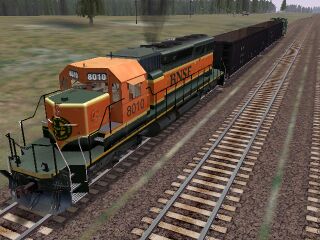

It is also the only standard cab locomotive BNSF painted with silver trucks and fuel tank.īNSF 696 a Former ATSF Warbonnet Dash 9 that worked on the ATSF Around the 1990 to 1995 until the merger this was Trailing on a Grain Train with Ferromex Hoppers Spotted In Crowley TX on Former ATSF Trackage Trivia BNSF #2099 (GP38-2) was the first older unit repainted in H1. Many former patched and unpatched (units or locomotives with patchwork) BN and ATSF units still exist on their roster, but are often mistaken for their counter-part's existence to which most average people confuse the preceding ATSF and BN railroad's existence with the lettering and paint schemes still remaining as opposed to being fully-repainted into the current, succeeding company's scheme.Īside from the H1 and H2 logo's being from ATSF origin, the H1 scheme is designed after the BN's "cascade" scheme used on their SD70MAC's, with the H2 scheme being more simple like with the BN's primary scheme, but having an ATSF-style hood logo and side lettering.īNSF #961 was the first new locomotive to wear the company's first official paint scheme. The paint schemes we're used from the Great Northern railway. The H3 scheme has the same design as the H2 scheme, but with the "swoosh" logos added (the color schemes are often nicknamed " pumpkin" or " pumpkins" by enthusiasts). Their paint scheme or livery colors are orange, yellow and black (although sometimes dark green) on their H1, H2, and H3 schemes. In 1999, the "Heritage 2" (H2) scheme was introduced with ATSF-style lettering, with the current "Heritage 3" (H3) scheme being released in 2005 with their current "swoosh" style logo, which is considered to be the first official logo to be completely new and original.

In 1996, a shy year after the merger, BNSF officially established their first official paint scheme known as "Heritage 1" (H1), which consists of having an ATSF-style logo as their official logo.

The success of the creation of BNSF led to having more trains over the former ATSF and BN's rail lines (as well as the expansion of other lines), more customers, the retirement of older locomotive units (such as the F45), the purchase of newer locomotive types (such as the Dash 9), and the creation of a new scheme and logo for the new company's locomotive fleets.īNSF's history is still being written as of today.īNSF operates over former ATSF trackage throughout: During BNSF's creation, however the railroad experienced such issues, but was able to manage.Īlthough the ATSF and BN's merger was one of the results of the decline, yet the merger was one of the most successful railroad mergers (besides CSX) to actually not have any financial issues (unlike Penn Central) though the railroad briefly struggled during numerous market spikes (as listed above), and to not have absorbed one another like with the Union Pacific and Southern Pacific merger in 1996. Though, before 1995, 1996, and 1999 when such railroads as the SP, Conrail, CNW, and DRGW became defunct, the railroad freight market experienced several spikes (both negative and positive) during such times during the "Mega Mergers" during the 1990's. As opposed to having over 60 or more Class 1 freight railroads covering the 48 mainland states throughout the nation, they became narrowed down to about 8 as a result of the "Railroad Hell" or the "Decline of Railroads" throughout the United States. BNSF's original logos top being H2, bottom being H1.ĭuring the early 1990's, the last original remaining US Class 1 railroads were slowly in the process of becoming absorbed or merging into other railroads which began the next generation of railroading.


 0 kommentar(er)
0 kommentar(er)
